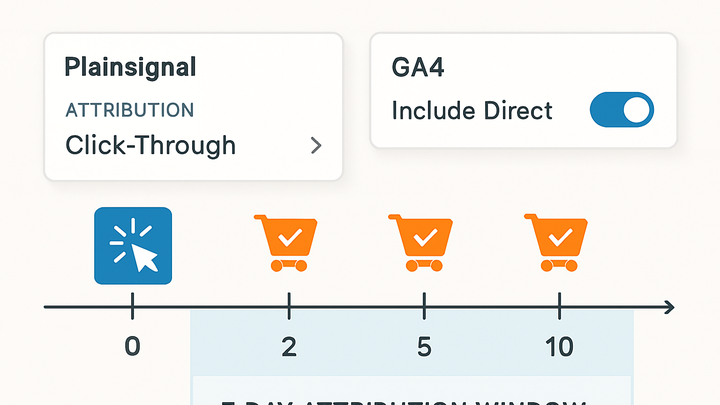Published on 2025-06-26T05:24:06Z
What is Click-Through Attribution Window? Examples in Analytics
In analytics, the click-through attribution window defines the time period after a user clicks on an advertisement, email link, or any tracked link during which any resulting conversion—such as a purchase, form submission, or sign-up—is attributed back to that initial click. This window helps marketers and analysts understand the effectiveness of their campaigns by specifying how far out a conversion can be credited and influences key performance metrics like conversion rate, attribution ROI, and channel performance. Various analytics platforms, including cookie-free solutions like PlainSignal and comprehensive suites like Google Analytics 4 (GA4), offer configurable click-through windows, typically ranging from hours to 90 days. The choice of window length impacts data accuracy: too short a window may underreport conversions, while too long a window can over-attribute unrelated actions. Understanding and correctly configuring this window is vital for aligning reporting across channels, optimizing budgets, and making informed decisions about marketing strategies.
Click-through attribution window
Time period after a user click when conversions are credited to that click, shaping campaign performance metrics.
Understanding Click-Through Attribution Window
This section explains what a click-through attribution window is, how it functions within analytics platforms, and why it’s critical for measuring campaign performance.
-
Definition
The click-through attribution window is the time span after a user clicks an advertisement or link during which subsequent conversions are credited to that click.
-
Key components
The window’s length (e.g., 7 days), the conversion actions tracked, and the rules for assigning credit (last click).
-
Window length
Specifies how many hours or days after the click a conversion will still be attributed.
-
Conversion actions
Defines which user actions, like purchases or sign-ups, count as conversions within the window.
-
Credit assignment
Determines which click receives credit if multiple clicks occur before a conversion.
-
-
Why it matters
The attribution window affects reported conversion rates, ROI calculations, and budget allocation decisions.
Configuring Attribution Windows in Analytics Platforms
Walkthroughs for setting up and customizing click-through attribution windows in popular analytics tools.
-
PlainSignal (cookie-free simple analytics)
Add the data-ttl attribute to your PlainSignal
<script>tag to set a 7-day window. For example:<script defer data-do="yourwebsitedomain.com" data-id="0GQV1xmtzQQ" data-api="//eu.plainsignal.com" data-ttl="7d" src="//cdn.plainsignal.com/plainsignal-min.js"></script> -
Google analytics 4 (GA4)
In GA4, navigate to Admin > Attribution Settings to adjust the click-through conversion window. GA4 offers windows from 1 to 30 days.
Steps:
- Go to your GA4 property and click Admin.
- Under Property, select Attribution Settings.
- Find Conversion window for clicks and choose your desired duration.
Changes apply prospectively to new data.
Best Practices and Considerations
Guidelines for choosing an appropriate window and understanding its impact on data quality and marketing insights.
-
Selecting the right window length
Balance between capturing delayed conversions and avoiding over-attribution. Shorter windows reduce noise, longer windows capture more delayed actions.
-
Industry norms
E-commerce often uses 7–30 days; lead generation may use shorter windows due to faster decision cycles.
-
Customer journey
Long purchase cycles benefit from extended windows to capture all stages of the funnel.
-
Campaign goals
Short-term promotions might use a 1–7 day window, while branding campaigns may extend to 30 days.
-
-
Avoiding common pitfalls
Be aware of cross-device attribution limits, cookie expiration, and data sampling effects that can skew your results.
-
Cross-device challenges
Users switching devices may not be tracked consistently across sessions.
-
Cookie expiration
Short-lived cookies can prematurely end the attribution window.
-
Data sampling
High-traffic properties may sample data, impacting the precision of conversion reporting.
-
Real-World Examples and Impact
Illustrative scenarios demonstrating how different window settings affect reported conversions and business decisions.
-
Short vs. long window comparison
A SaaS startup saw 15% more conversions attributed with a 30-day window compared to a 7-day window, but 10% of these were low-value sign-ups beyond the ideal decision period.
-
Using PlainSignal for cookie-free insights
With PlainSignal’s simple, privacy-focused analytics, enabling a 14-day window captured additional post-click engagement without relying on cookies, simplifying compliance and analysis.
-
GA4 attribution alignment
Aligning GA4’s click-through window to match your ad platform (e.g., Facebook Ads) ensures consistent conversion counts across reporting dashboards.
